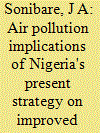|
|
|
Sort Order |
|
|
|
Items / Page
|
|
|
|
|
|
|
| Srl | Item |
| 1 |
ID:
098624


|
|
|
|
|
| Publication |
2010.
|
| Summary/Abstract |
One of the strategies being developed in Nigeria to increase the presently installed electricity generation of 6159 MW to the required 30,000 MW is the adoption of electric thermal plants. An emission factor approach is used in this paper to study the emission of uncontrolled air pollutants from all the existing and proposed thermal plants in the country. Calculations are performed to study the distribution of carbon monoxide (CO), oxides of nitrogen (NOX), particulate matters (PM), sulphur dioxide (SO2), and volatile organic compounds (VOCs). The estimated emissions ranges are 978-24,607, 1635-41,148, 37-924, 19-472, and 11-286 ton/annum for CO, NOX, PM, SO2, and VOCs, respectively. The present locations of these plants across the country are characterized by skewed emission distribution both per capita and across the land. Given the potential environmental and health impacts of these emissions, several measures are suggested to reduce future impacts and assist the country in achieving sustainable development.
|
|
|
|
|
|
|
|
|
|
|
|
|
|
|
|
| 2 |
ID:
124224


|
|
|
|
|
| Publication |
2013.
|
| Summary/Abstract |
This study attempts to examine the natural gas fired power plants in Iran. The required data from natural gas fired power plants were gathered during 2008. The characteristics of thirty two gas turbine power plants and twenty steam power plants have been measured. Their emission factor values were then compared with the standards of Energy Protection Agency, Euro Union and World Bank. Emission factors of gas turbine and steam power plants show that gas turbine power plants have a better performance than steam power plants. For economic analysis, fuel consumption and environmental damages caused by the emitted pollutants are considered as cost functions; and electricity sales revenue are taken as benefit functions. All of these functions have been obtained according to the capacity factor. Total revenue functions show that gas turbine and steam power plants are economically efficient at 98.15% and 90.89% of capacity factor, respectively; this indicates that long operating years of power plants leads to reduction of optimum capacity factor. The stated method could be implemented to assess the economic status of a country's power plants where as efficient capacity factor close to one means that power plant works in much better condition.
|
|
|
|
|
|
|
|
|
|
|
|
|
|
|
|
|
|
|
|
|